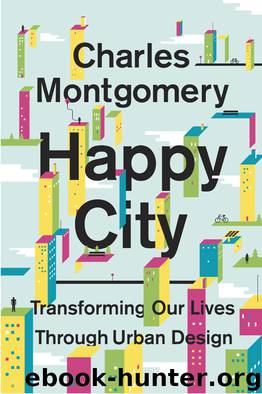Happy City by Charles Montgomery

Author:Charles Montgomery [Montgomery, Charles]
Language: eng
Format: epub
ISBN: 978-0-385-66913-9
Publisher: Doubleday Canada
Published: 2013-11-11T16:00:00+00:00
First We Shape Our Streets, Then They Shape Us
A white male living in Midtown (left), near Atlanta’s downtown, is likely to weigh ten pounds less than his identical twin living near Mableton (right), a sprawling suburb. This is partly owing to road geometry and land-use mix: a ten-minute walk from a home amid the traditional grid in Midtown will get you to grocery stores, churches, schools, bus stops, restaurants, cafés, a dry cleaner, a bank, and the glorious lawns of Piedmont Park. But the spread-out and homogeneous system of Mableton pushes destinations beyond walking range, which means residents are likely to drive whether they like driving or not. (Each bullet represents a school, church, grocery store, dry cleaner, bank, day-care center, police station, transit stop, or hospital. If restaurants, cafés, bars, and other services were included, the Mableton map would not change, but the Midtown map would be sprayed with dozens more bullets.) (Erick Villagomez, Metis Design Build)
Our responses to distance are quite predictable. Most of us will walk to a corner store rather than climb in and out of the car if it’s less than a five-minute walk—about a quarter mile—away. We won’t walk more than five minutes to a bus stop, but we will walk ten to a light-rail or subway station, partly because most of us perceive rail service to be faster, more predictable, and more comfortable. This is the geometry perfected by streetcar city developers a century ago. It’s now being rediscovered by planners who find that simply introducing regular high-quality light-rail service can alter the habits—and the health—of people nearby. Less than a year after the LYNX commuter light-rail line was installed in Charlotte, North Carolina, people living near the line had started walking an extra 1.2 miles every day because the system changed their daily calculus. People who switched to the LYNX for their commute lost an average of six and a half pounds during that time.
Kids move by a similar calculus. Frank found that if there is a park or some kind of store within a half mile of their home, school-age youth are more than twice as likely to walk. If destinations are farther, they wait for a parental chauffeur. Think of the implications: a community with one central mega–sports complex with several baseball diamonds and soccer fields can actually be bad for children’s health if it replaces small parks scattered every few blocks. In the finer-grained community, instead of begging Mom for a ride to a league game, a teenager might find it easier to organize her own game at the local park.* Nearly two-thirds of parents say there is no place for their children to play within walking distance of home. This is part of the reason that American children now actually gain weight during the supposedly leisure-filled summer break.
“The way we organize most cities actually encourages individuals to make choices that make everyone’s life harder,” Frank told me. “The system fails because it promises rewards for irrational behavior.”
Put simply, most people do not walk in American cities because cities have designed destinations out of reach.
Download
This site does not store any files on its server. We only index and link to content provided by other sites. Please contact the content providers to delete copyright contents if any and email us, we'll remove relevant links or contents immediately.
The Secret History by Donna Tartt(16605)
The Social Justice Warrior Handbook by Lisa De Pasquale(11485)
Thirteen Reasons Why by Jay Asher(7777)
This Is How You Lose Her by Junot Diaz(5747)
Weapons of Math Destruction by Cathy O'Neil(5027)
Zero to One by Peter Thiel(4815)
The Myth of the Strong Leader by Archie Brown(4783)
Promise Me, Dad by Joe Biden(4439)
Stone's Rules by Roger Stone(4409)
Beartown by Fredrik Backman(4398)
How Democracies Die by Steven Levitsky & Daniel Ziblatt(4391)
The Fire Next Time by James Baldwin(4336)
100 Deadly Skills by Clint Emerson(4069)
A Higher Loyalty: Truth, Lies, and Leadership by James Comey(4024)
Rise and Kill First by Ronen Bergman(4006)
The David Icke Guide to the Global Conspiracy (and how to end it) by David Icke(3874)
The Farm by Tom Rob Smith(3868)
Secrecy World by Jake Bernstein(3773)
The Doomsday Machine by Daniel Ellsberg(3725)
